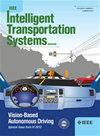交通信号控制的半“智能预测再优化”方法
IF 5
3区 工程技术
Q1 ENGINEERING, ELECTRICAL & ELECTRONIC
IEEE Intelligent Transportation Systems Magazine
Pub Date : 2023-11-01
DOI:10.1109/mits.2023.3284059
引用次数: 0
摘要
本文章由计算机程序翻译,如有差异,请以英文原文为准。
A Semi-“Smart Predict, Then Optimize” Method for Traffic Signal Control
An efficient intersection signal scheme is of vital significance to urban traffic operation. At present, multiperiod fixed-timing control is still the traffic signal control method adopted by many urban intersections. For the optimization problem of signal scheme selection at signalized intersections, we proposed three two-step prediction optimization methods that match the traffic arrival in different periods with the corresponding optimal signal scheme, aimed at reducing the total delay of vehicles at signalized intersections. The first method predicts the traffic flow in each entrance direction of the intersection by minimizing the mean square error (MSE), then obtains the total vehicle delay of each scheme in the signal scheme set through the Highway Capacity Manual 2010 delay formula, and finally substitutes it into the signal optimization model to obtain the optimal scheme combination. The second method directly predicts the total vehicle delay at intersections of all signal schemes by minimizing the MSE and then substitutes it into the signal optimization model to obtain the optimal scheme combination. The third method directly predicts the total vehicle delay at intersections of all signal schemes by minimizing both the MSE and the prediction error between every two schemes and then substitutes it into the signal optimization model to obtain the optimal scheme combination. Verification based on actual intersection shows that better optimization results can be obtained by integrating optimization objectives into the prediction process. Besides, some practical insights can be drawn through applicability analysis and sensitivity analysis. First, the proposed model is more suitable for intersections where traffic arrivals vary greatly. Second, with the increase of scheme differences within a certain range, the advantages of the proposed method become more obvious. Finally, it is necessary to balance the flexibility of traffic control with control effectiveness in practical applications.
求助全文
通过发布文献求助,成功后即可免费获取论文全文。
去求助
来源期刊

IEEE Intelligent Transportation Systems Magazine
ENGINEERING, ELECTRICAL & ELECTRONIC-TRANSPORTATION SCIENCE & TECHNOLOGY
CiteScore
8.00
自引率
8.30%
发文量
147
期刊介绍:
The IEEE Intelligent Transportation Systems Magazine (ITSM) publishes peer-reviewed articles that provide innovative research ideas and application results, report significant application case studies, and raise awareness of pressing research and application challenges in all areas of intelligent transportation systems. In contrast to the highly academic publication of the IEEE Transactions on Intelligent Transportation Systems, the ITS Magazine focuses on providing needed information to all members of IEEE ITS society, serving as a dissemination vehicle for ITS Society members and the others to learn the state of the art development and progress on ITS research and applications. High quality tutorials, surveys, successful implementations, technology reviews, lessons learned, policy and societal impacts, and ITS educational issues are published as well. The ITS Magazine also serves as an ideal media communication vehicle between the governing body of ITS society and its membership and promotes ITS community development and growth.
 求助内容:
求助内容: 应助结果提醒方式:
应助结果提醒方式:


